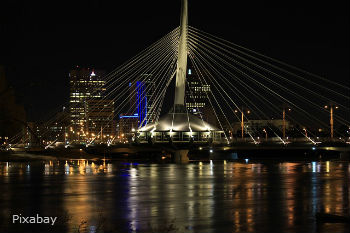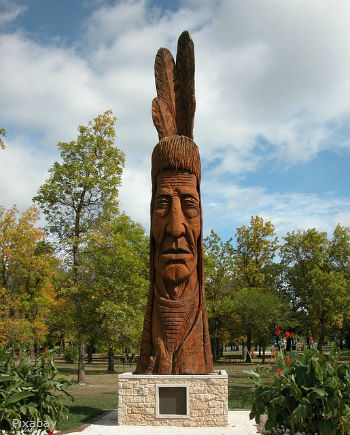The capital of Manitoba, Winnipeg was an important trading centre long before Europeans settled in Canada. The city gets its geographical  significance and name, which means “muddy waters” in the aboriginal language Western Cree, from its location at the confluence of two major rivers: the Red River and the Assiniboine. Winnipeg remains important in modern Canada as the “Gateway to the West” because of its prominence as a hub in cross-country transportation. If you are ready to move to Winnipeg, read on to find out if the city is right for you.
Winnipeg’s Climate
According to the Köppen Climate Classification system, Winnipeg has a “humid continental” climate. It has four distinct seasons with cold winters, humid summers and temperate spring and fall seasons.
Winnipeg’s location in the Canadian Prairies causes it to be on the colder end of its “humid continental” classification. The daily mean temperature is only about 19 degrees Celsius in the summer, while the average temperature in the winter is a chilly -14. Meanwhile, the “mild” spring and fall seasons seem cold to people who have moved to the city from a location farther south. Highs in April and October are usually only about 10 degrees.
Winnipeg experiences about 5,100 millimetres of precipitation each year. Summer months are the wettest, and have frequent thunderstorms. Although the colder months have less precipitation, snow can accumulate any time between October and April.
Winnipeg Neighbourhoods
If you’re moving to Winnipeg, you can make your home in one of its 236 official neighbourhoods. Downtown Winnipeg is where everything starts, with densely populated neighbourhoods radiating from it in all directions.
Downtown is the city’s fastest growing high-income neighbourhood. Over 72,000 people work in the area, while about 40,000 students attend the colleges and universities there. If you live near the intersection of Portage Avenue and Main Street, you’re right in the middle of downtown and the heart of the city.
You can find more residential neighbourhoods just outside of Downtown-- especially to the south and west of the urban centre. Here, you’ll find Osborne Village, the most densely populated neighbourhood in both Winnipeg and the entire province of Manitoba.
Winnipeg is demographically noteworthy for having a significant population of Aboriginals. Although they tend to be younger and poorer than other Winnipeg residents, roughly 12 percent of the population is Aboriginal and that number is trending upwards. Other than reservations, Winnipeg has the highest concentration of Aboriginals in a Canadian city.
The remaining 88 percent of the population is 66 percent white and 22 percent non-Aboriginal visible minorities. Winnipeg is a diverse city with many unique cultural neighbourhoods, welcoming over 10,000 immigrants a year.
Despite this diversity, English is overwhelmingly prevalent-- 99 percent of the population is fluent in English, which is ironic since there are over 100 spoken languages in this culturally diverse city.
Crime is a major concern in Winnipeg. It has one of the worst crime rates in the country and the dubious distinction of being “the murder capital of Canada.” Winnipeg has had the highest violent crime index in the country since 2009.
Despite these discouraging numbers, most of the crime is concentrated in a relatively small area, with the highest crime neighbourhoods bordering each other. Unfortunately, this 25 neighbourhood danger zone is right in the heart of Downtown, and includes Central Park, the Portage/Main Street intersection, Chinatown and West Broadway.
Winnipeg Schools
Winnipeg has seven primary and secondary education public school districts. The most notable of these is the Winnipeg School Division, which educates the majority of the city‘s children. There are also a few private secular and religious options for Winnipeg parents.
Winnipeg has several post-secondary institutions, as well. The University of Manitoba is the biggest university in both the city and the province. It usually enrolls 24,500 undergraduates and 4,000 graduates each year.
Other universities in Winnipeg include:
- Université de Saint-Boniface: The city’s only French language university.
- University of Winnipeg: As a younger university, it only offered undergraduate courses until 2007. It now has its own graduate programs.
- Canadian Mennonite University: This private university was established as the city’s only Mennonite institution in 1999.Economy
Winnipeg's Economy
Winnipeg’s location as the gateway to the west and at the convergence of two major rivers helps drive its diverse economy. Overall, Winnipeg’s economy ranks fourth in Canada, behind just Toronto, Calgary and Regina.
You have many options if you are looking for employment from Winnipeg’s 21,000 employers. Trade, manufacturing, healthcare and education are some of the leading industries in the city, but none constitute more than 16 percent of the city’s economy.
In January of 2014, Winnipeg employed approximately 416,700 people and that number could grow. Unemployment has dropped in recent years to 5.8 percent, which is just below the Canadian average.
Winnipeg's Cost of Living

Canada’s prairie cities tend to have a low cost of living compared to cities in other regions. Swiss international auditor KPMG ranked Winnipeg as the least expensive place for business in 2012, which helps keep costs down for the average consumer. Excluding rent, the city’s Consumer price index (CPI) is a low 70.86, according to cost of living calculator, Numeo. The average rent for a one-bedroom apartment in the city centre is $826 a month.
Registering Your Car in Winnipeg
If you are moving to Winnipeg from outside of Manitoba, you will need to register your car with Manitoba’s government. You need insurance, a new inspection, and proof of ownership. Certain businesses, students and Saskatchewan residents who live near the Manitoba border may not need to get a new vehicle registration. Visit Manitoba Public Insurance to get all the information you need to register your car. Winnipeg Transportation
As the “Gateway to the West,” Winnipeg is a major stop on both the Canadian Pacific Railway, and the Canadian National Railway. It also has direct rail connection to the US, which is unique for a Canadian Prairie city.
Via Rail and Winnipeg Transit serve Winnipeg’s commuters by operating the rail and bus systems respectively. Head to Winnipeg Transit to plan your commute if you want to avoid delays.
Alternately, Winnipeg taxis and bicycle paths give commuters other options for getting around the city. Over half of Winnipeg’s residents use a taxi at least once a year and many residents choose to bike to work, even in the freezing winter months. Manitoba even has an annual Bike to Work Day to encourage commuters to use the city’s many bike paths.

Winnipeg's Culture and Contemporary Life
In 2010, Canadian Heritage named Winnipeg a cultural capital due to its Aboriginal history and its 26 National Historic Sites of Canada. Among the sites, The Forks is the most noteworthy--attracting four million visitors a year. However, you’d be wrong to think the Forks are just about history. Families will appreciate several kid-friendly attractions like the Manitoba Theatre for Young People, the Manitoba Children’s Museum, and the Winnipeg International Children’s Festival.
Downtown Winnipeg offers diverse cultural dining options that represent the unique mix of Aboriginal, European and other immigrant demographics that populate the city. Taste some of the city’s hot-smoked fish, confectionary treats, schmoo torte, and wafer pie.
Downtown Winnipeg is also home to a variety of theatres and museums for the art enthusiast. The Manitoba Museum is the city’s largest and a good place to explore the history of the city. The Winnipeg Art Gallery focuses on aboriginal art. The recently opened Canadian Museum for Human Rights offers unparalleled insight into humanity.
Winnipeg also hosts many annual festivals, including:
- Winnipeg Music Festival
- Winnipeg Fringe Theatre Festival
- Winnipeg International Writers Festival
Winnipeg Moving Resources
Are you ready to move to Winnipeg? Topmoving.ca has a database of moving companies that can offer you moving, international shipping, and auto transport services for the city. Remember to get at least three different quotes from various companies to help you determine a fair price for your move.
Winnipeg Relocation Tips
- Avoid the traffic and bike to work. Winnipeg has many bike paths and strives to be bike-friendly.
- Avoid moving to dangerous neighbourhoods by researching an area before you commit to living there. A small section of the city is a notoriously high crime area.
- It is worth paying a little more in rent to live in a better neighbourhood. The cost of living in relatively low in Winnipeg.
- Bring warm clothes. The winters are very cold.
- Visit the Forks for a plethora of fun family activities.
Helpful Links
|